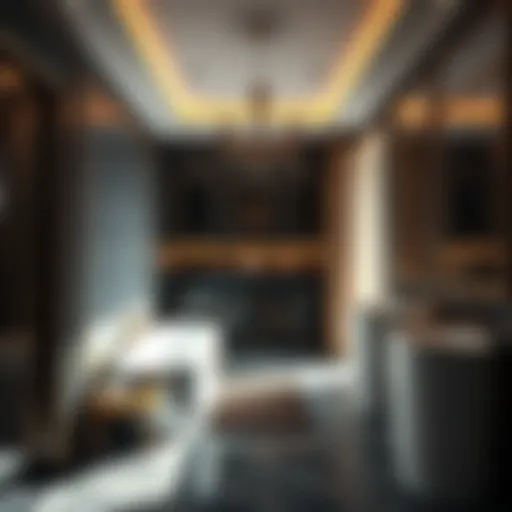Master Bedroom Coastal Design: A Comprehensive Guide
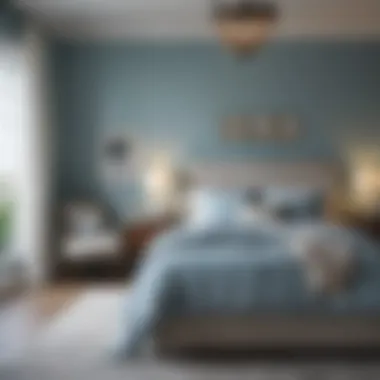

Intro
Coastal design evokes a sense of layered tranquility, drawing inspiration from the natural beauty of shorelines. It emphasizes a light, airy atmosphere that reflects the breezy allure of coastal living. In a master bedroom, this design philosophy can transform a personal space into a serene retreat. Homeowners who navigate this aesthetic often find harmony in their environments, as each design element plays a crucial role.
This guide aims to delve into essential aspects of crafting a coastal-inspired master bedroom. We will cover trending styles, curated color palettes, suitable materials, thoughtful furniture choices, and enticing decorative elements. The goal is to provide a comprehensive resource that empowers homeowners and decorators alike, cultivating spaces where functionality meets style. The insights shared here will not only enlighten choices but also encourage a balanced approach to design.
Trending Styles
In coastal design, trending styles vary but usually center around two predominant themes. This includes modern minimalism and cozy rustic aesthetics.
Modern Minimalism
Modern minimalism in coastal design focuses on clean lines and simplicity. It favors open spaces that allow for easy movement while maximizing natural light. The integration of unobstructed views enhances the feeling of spaciousness, which is crucial for achieving a coastal atmosphere. Furniture is often sleek and understated, enhancing functionality while adding to the overall design.
Cozy Rustic
Conversely, cozy rustic embodies warmth and comfort. This style employs natural materials like wood and stone, establishing a tactile connection to nature. Elements such as reclaimed wooden beams or weathered furniture add depth and character. Soft textiles and layered bedding play essential roles in welcoming occupants to enjoy a relaxing atmosphere, which aligns perfectly with the coastal ethos.
Color Palettes
Choosing the right color palette is paramount in achieving the desired coastal vibe. Two effective approaches include calming neutrals and bold accents.
Calming Neutrals
Calming neutrals typically encompass shades like soft whites, sandy beiges, and muted grays. These tones serve as a perfect backdrop, creating a sense of calmness that mimics the soothing qualities of the beach. Often, hues are inspired by the sea and sky, enhancing the serene ambiance of the master bedroom.
Bold Accents
To add visual interest, bold accents can be strategically introduced. Colors like deep navy, vibrant turquoise, or even coral can be used sparingly. These hues evoke the essence of coastal ecology and can be incorporated through decorative pillows, art pieces, or wall decorations. This approach maintains a balance between tranquility and dynamic styling, allowing for a cohesive yet striking design.
"The color palette is not merely an aesthetic choice; it shapes the emotional experience of the space."
In summary, coastal design is about more than just looks; it’s about creating an atmosphere that resonates with peace and comfort. By analyzing trending styles and selecting appropriate color palettes, homeowners can craft a master bedroom that truly reflects coastal living.
Understanding Coastal Design
Understanding coastal design is essential for creating a master bedroom that captures the essence of a serene beachside retreat. This design style emphasizes tranquility, comfort, and a connection to nature, which can significantly enhance the living environment. By applying coastal design principles, homeowners can create spaces that not only look visually appealing but also promote a sense of well-being and relaxation.
Coastal design incorporates specific elements that serve to evoke feelings of the ocean and sandy shores. Colors, textures, and materials all contribute to this aesthetic, making it vital to choose components that harmonize with one another. The benefits of understanding these design principles include improved ambiance, better functionality, and a more cohesive overall look. The choice of furniture, textiles, and decorative elements can be guided by coastal design fundamentals, ensuring every aspect of the room fits the desired aesthetic.
Defining Coastal Design Aesthetics
Coastal design aesthetics revolve around a fresh, airy, and relaxed atmosphere. Typically, this style uses a soft color palette dominated by blues, greens, and neutrals. These colors mimic the sky, sea, and sandy shores, creating calming visual cues in your space.
Textures play a crucial role in defining this aesthetic as well. Natural materials such as wood, linen, and cotton are frequently employed, enhancing the organic feel of a coastal-themed bedroom. Soft, lightweight fabrics are common, as they allow for comfortable layering and easy maintenance. This approach not only reinforces the aesthetic but also adds functional comfort, making it ideal for a bedroom.
Key Elements of Coastal Aesthetic:
- Color: Blues about the ocean, soft greens for tranquility, and neutrals for balance.
- Materials: Natural fibers to enhance comfort and aesthetics.
- Lighting: Emphasizing brightness and airy atmospheres, often utilizing natural light.
Historical Influences on Coastal Design
Coastal design has evolved over the years, influenced by various historical movements and regional styles. Traditionally, coastal homes were designed to withstand the harsh maritime environment while reflecting the surrounding natural beauty. The use of light colors and airy spaces can be traced back to colonial architecture, where homes near the shore sought to maximize airflow.
As the design styles progressed, influences from the Mediterranean and Caribbean regions began to shape the coastal aesthetic. Motifs from these areas often include ornate tile work, vibrant colors, and an emphasis on outdoor living spaces. In modern interpretations, the blend of historical perspectives has resulted in a refreshed look that balances functionality with style, appealing to today’s homeowners.
Understanding these historical influences helps to craft a coastal bedroom that is not just trendy but grounded in tradition. This depth adds character to the design, telling a story about the relationship between architecture and environment.
"The essence of coastal design lies not only in visual beauty but in its ability to connect us to nature and history."
Essential Color Palettes
In coastal design, the selection of an appropriate color palette is foundational. Color influences mood, ambiance, and perception of space. Thus, integrating essential colors that reflect the natural surroundings is critical for achieving that serene coastal atmosphere. This section discusses the significance of various color groupings including soft blues and greens, neutrals and earth tones, and the strategic use of bold accents. By carefully choosing colors, homeowners can create a cohesive and tranquil retreat that embodies the coastal lifestyle.
Soft Blues and Greens
Soft blues and greens are often the cornerstone of coastal design. These hues mimic the sky and sea, bringing a calm and refreshing energy into any master bedroom. Light blue tones can evoke feelings of tranquility and open space, which is particularly beneficial in a bedroom setting. Similarly, soft greens, reminiscent of sea glass and lush coastal flora, provide a sense of balance and connection to nature.
- Psychological Benefits: Studies suggest that shades of blue help to lower blood pressure and manage stress levels. Incorporating these colors can enhance relaxation and promote better sleep.
- Versatility: Soft blues and greens pair well with a variety of materials and textures making them adaptable to diverse designs.
- Layering Options: Using different shades of blues and greens can add depth to the room. Pale tones can be applied on walls, while darker shades can be reserved for textiles or smaller accents.
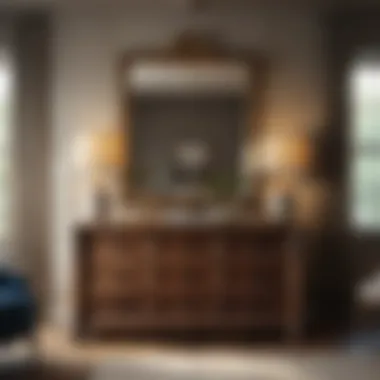

Neutrals and Earth Tones
Neutrals and earth tones serve as a perfect backdrop in coastal bedrooms, promoting comfort and warmth. These colors include sandy beiges, soft greys, and muted browns. They are invaluable in creating a harmonious environment that allows other colors to stand out without overwhelming the senses.
- Blending with Nature: Neutral tones effectively bridge the gap between indoor spaces and the great outdoors. They reflect natural elements such as stone, driftwood, and sandy beaches.
- Enhancing Natural Light: Lighter neutrals can help amplify the light in a room, resulting in an airy feel that is both inviting and refreshing.
- Cohesive Design: earth tones foster consistency in design, allowing for various decorative elements and furnishings to work together seamlessly.
Accents of Bold Colors
Strategically introducing bold colors can enhance the coastal décor while providing points of interest throughout the bedroom. While soft blues and greens are calming, accents in coral, navy, or even deep teal can invigorate the space and give it a more dynamic aesthetic.
- Creating Focal Points: Using bold colors in certain areas, such as throw pillows, artwork, or an accent chair, can draw attention to those elements without overpowering the overall calmness of the room.
- Personal Expression: Accents allow homeowners to showcase their personality. A vibrant piece of art or a striking lamp can serve as a conversation starter and reflect personal style.
- Balance and Contrast: Incorporating bursts of bold color can create a beautiful contrast against softer background shades, making the space visually appealing.
"Color is a powerful communication tool and can be used to signal action, influence mood, and even influence physiological responses."
Each of these color categories enhances the coastal design ethos in a master bedroom. By understanding their impact, homeowners can curate environments that promote relaxation and reflect their personal style.
Material Selection for Coastal Design
In coastal design, material selection is a crucial factor that deeply influences the overall aesthetic and functionality of a master bedroom. Each material contributes to the desired atmosphere. Natural, enduring, and often sustainable materials can evoke the serenity and balance associated with coastal living. When choosing materials, consider durability, maintenance, and environmental impact.
Effective material selection ensures a harmonious environment. It reflects your personality and enhances comfort while echoing the natural elements found in coastal settings. Therefore, understanding available options is key to achieving a beautiful coastal bedroom.
Natural Fiber Textiles
Natural fiber textiles, such as cotton, linen, and wool, play an important role in coastal design. These fabrics provide not only comfort but also a sense of connection to nature. Cotton is breathable, which makes it an excellent choice for bedding. Linen adds texture and a casual elegance, while wool can offer warmth during cooler months.
Natural fibers are also aligned with sustainable practices. They often have less environmental impact compared to synthetic options. When selecting textiles, opt for organic or eco-friendly fabrics. This choice supports both sustainability and health, as synthetic materials can emit harmful chemicals.
Consider using a mix of textures to enhance visual interest. Layering different textiles, such as a linen duvet cover with cotton sheets, creates a cozy and inviting atmosphere.
Reclaimed Wood Furniture
The trend of using reclaimed wood furniture is not just stylish; it aligns with sustainable practices. Reclaimed timber brings character and history into your master bedroom. Each piece is unique, telling a story, and often displaying beautiful imperfections that enhance its charm.
When selecting reclaimed wood, look for furniture that has been responsibly sourced and treated to ensure durability. This type of furniture tends to be sturdy and long-lasting. Additionally, the warm tones of reclaimed wood can create a calming and inviting space that mirrors the organic feel of coastal environments.
Incorporating reclaimed wood pieces, such as a bed frame or nightstands, contributes to an earthy color palette. This practice not only enhances aesthetics but also helps reduce waste, making it an excellent choice for environmentally-conscious homeowners.
Ceramics and Glass Accents
Ceramics and glass accents are essential for adding layers to coastal design. Both materials can elevate the coastal theme by introducing various textures and finishes. Ceramics often come in soothing colors and can be used for decorative vases or planters, which can add life to the room.
Glass, on the other hand, is ideal for creating a sense of lightness and airiness. Consider using glass lamps or decorative bowls. The reflective quality of glass can also enhance the natural light in your space. When arranged thoughtfully, glass pieces can mimic the ever-changing nature of the sea and sky.
Both ceramics and glass can also incorporate the accents of blue and green hues commonly found in coastal settings, contributing to the overall theme.
"The right materials can transform your master bedroom into a serene coastal retreat, embracing nature's beauty and comfort."
Choosing materials for a coastal bedroom has a significant impact on the space. By focusing on natural fiber textiles, reclaimed wood furniture, and ceramics and glass accents, you can create an inviting and harmonious atmosphere that embodies the essence of coastal design.
Furniture Choices
Furniture choices significantly shape the overall ambiance of a coastal master bedroom. Selecting the right pieces can enhance both aesthetics and functionality, creating a tranquil retreat that echoes a seaside lifestyle. Each element serves a purpose, ranging from comfort to storage, and can seamlessly blend with the overall design theme while showcasing personal style.
Bed Frames and Mattresses
Choosing a bed frame is essential in achieving the coastal design aesthetic. Opt for materials like driftwood or whitewashed finishes that evoke a sense of sandy shores. Sleigh beds or platform beds with clean lines can impart a sleek look, complementing soft textiles.
Comfort is equally critical. Investing in a quality mattress can improve sleep quality, a key aspect of any bedroom. Look for mattresses that align with your preferred sleeping position. Memory foam options offer support while adapting to body shape, contributing to restful sleep essential for well-being.
Accent Chairs and Benches
Accent chairs and benches add elegance and comfort to the coastal design. These pieces can support activities like reading or relaxing, enhancing usability. Choose chairs that feature natural fabrics and soft colors for a fresh feel. Wicker or rattan chairs can also evoke a beachy vibe.
Benches serve as functional decor. They can act as a spot to sit while dressing or be a place to set items. Look for benches with storage options beneath, ideally made from materials such as reclaimed wood or upholstered in light fabrics. This promotes an organized decor while maintaining that casual, laid-back coastal feel.
Storage Solutions in Coastal Design
Storage solutions are not only practical but are also a design statement. In a coastal bedroom, it is important to integrate functions that facilitate organization while maintaining aesthetic coherence. Consider using open shelving made from reclaimed wood, showcasing beach-related decor or books.
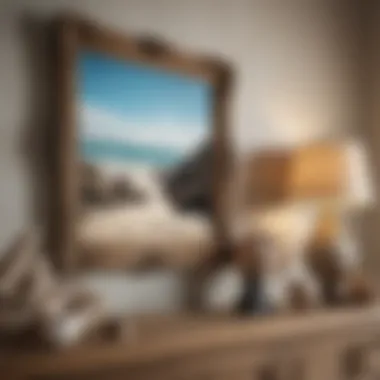

Also, storage beds are a wise investment. They work well for smaller spaces, offering hidden compartments to stow away linens and seasonal clothing. This organization maintains a clean look while embodying the essence of minimalism associated with coastal homes. Incorporating sea-inspired baskets for extra storage can also merge function with style, contributing to a cohesive design.
The choice of furniture should enhance the room's overall function while reflecting the calmness of coastal life.
Decorative Elements
The choice of decorative elements in a master bedroom plays a pivotal role in achieving the serene ambiance characteristic of coastal design. Decorative items are not merely aesthetic additions; they enhance the overall atmosphere and personalize the space. The right combination of art, lighting, and greenery can create a retreat that feels both inviting and tranquil. Each element should be thoughtfully considered to establish harmony and balance within the room.
Wall Art and Decor
Wall art serves as a focal point in any bedroom. For coastal design, artwork should evoke images of the sea and shore. Paintings or prints depicting seascapes, landscapes, or marine life can add a soothing vibe. The use of light colors and fluid shapes may reflect the movement of water and clouds, enhancing the connection to nature.
In addition to traditional art, consider using framed photographs from coastal vacations or local beach scenes. This personal touch creates not just decoration, but also a sense of nostalgia and warmth. Other decorative elements, such as seashells or driftwood, can be used either in shadow boxes or as standalone pieces on shelves and tables. This combination of items can lead to a cohesive story within the room.
Lighting Fixtures
Lighting is crucial in setting the mood of a master bedroom. In coastal design, the aim is to mimic natural light found near the water. For this purpose, consider using soft, warm-toned light fixtures. Pendant lights, floor lamps, or wall sconces fashioned from natural materials like rattan or light wood can contribute to a relaxed atmosphere.
Choosing fixtures that mimic the look of lanterns can bring a nautical feel. Moreover, dimmer switches can allow for flexibility in lighting. This way, brighter lights can illuminate the room during the day, while softer lights can create a calm environment in the evening. Consider also adding LED strip lights to shelves for a subtle glow that contributes to bedtime relaxation.
Indoor Plants and Greenery
Incorporating indoor plants into the master bedroom is an excellent way to enhance the coastal theme. Greenery brings life into the space, creating an organic connection to the beach and nature. Consider plants like snake plants or peace lilies, which are both low-maintenance and visually appealing.
Placing plants on windowsills or in decorative pots can draw the eye and add layers to the design. Hanging planters can also be an attractive option, adding dimension without taking up floor space. Additionally, plants can improve air quality, promoting overall wellness in the bedroom.
Incorporating decorative elements is not just about aesthetics; it is about creating a sense of place and comfort that invites relaxation.
By carefully selecting wall art, lighting fixtures, and indoor plants, homeowners can achieve a cohesive coastal design that resonates with serenity and personal touch. Each decoration enhances the overall atmosphere, resulting in a master bedroom that serves as a restorative retreat.
Textiles and Bedding
Textiles and bedding play a critical role in establishing the overall ambiance of a coastal master bedroom. They serve not just a functional purpose but also contribute to the aesthetic appeal of the space. When chosen thoughtfully, textiles can echo the natural beauty of coastal environments, enhance comfort, and create a sense of tranquility. Selecting the right materials can elevate your design, making it feel both inviting and sophisticated. Attention to texture, pattern, and fabric type is key in achieving a cohesive coastal look.
Choosing the Right Bed Linens
The choice of bed linens is fundamental in creating a peaceful retreat. Opting for light and breathable materials can help to maintain comfort while reflecting the airy feel of coastal designs. Cotton, linen, and bamboo are excellent choices due to their natural properties and durability. Consider selecting colors that align with the coastal palette such as soft blues or sandy beiges. Patterns can also enhance the theme—seashells, waves, or subtle stripes can evoke a nautical feel without overwhelming the senses. Always remember to check the thread count; higher counts usually indicate better quality, which adds to both comfort and longevity.
Layering Textures for Comfort
Layering textures is crucial in adding depth and warmth to your bedding arrangement. Begin with a solid base, such as a crisp white duvet cover, and gradually introduce elements like woven throws, quilted bedspreads, or chunky knitted blankets. Use decorative pillows in various sizes and shapes to create visual interest. Each layer not only enhances comfort but also allows for a mix of colors and patterns, reinforcing the coastal design. The contrast of smooth linens against rougher textiles can create a dynamic look, crucial in producing an inviting, lived-in appearance. This layering technique results in an inviting bed that beckons relaxation and comfort.
Curtains and Blinds Selection
Selecting the appropriate window treatments is essential in regulating light and maintaining privacy while enhancing the coastal aesthetic. Curtains made from lightweight, breathable fabrics such as sheer linen allow natural light to filter through, creating an open, airy feel. They also align with the coastal theme by mimicking the translucence of sea foam. For a more tailored look, consider using wooden blinds or woven shades. These materials can echo the hues of driftwood or sand, seamlessly integrating with other elements in the room. Ensure the colors are soft and harmonious, avoiding anything too dark that may detract from the serene atmosphere. Choosing the right curtains and blinds will hold the design together and significantly influence the overall ambiance.
Creating a Coastal Atmosphere
Creating a coastal atmosphere in your master bedroom is vital for achieving the relaxed, tranquil feelings associated with living near the sea. This design principle draws often from the beauty and simplicity of coastal landscapes. Elements like light, color, and texture come together to foster a serene retreat that mimics the clarity and serenity of the ocean.
The benefits of a coastal atmosphere are numerous. It can enhance your well-being by reducing stress and providing a comfortable, welcoming space. Furthermore, this atmosphere promotes a sense of openness and space, making your bedroom feel larger than it is. Achieving this environment requires an understanding of how to effectively incorporate various design elements into your space.
Incorporating Natural Light
Natural light plays a central role in creating a coastal atmosphere. It is essential because it mimics the sunlight reflecting off water, giving the room a bright and airy feel. To maximize natural light, consider the following:
- Window Treatments: Use sheer or light-filtering curtains to allow sunlight to bounce into the room while ensuring privacy.
- Placement: Position mirrors to reflect light and create a sense of depth, enlarging the space visually.
- Light Colors: Paint the walls in light shades like soft whites or pale blues to reflect more light in the room.
By emphasizing natural light, you are not only improving the aesthetics of your bedroom but also fostering a connection with the natural world outside.
Using Sea-Inspired Accessories
Sea-inspired accessories can transport you to the coast without leaving your home. These elements are essential in reinforcing the coastal theme while providing personal touches to the bedroom. Consider incorporating:
- Nautical Décor: Items like seashells, driftwood, or fishing nets can add to the coastal vibe.
- Artistic Touches: Artwork depicting beach scenes or nautical themes can evoke the beauty of the ocean.
- Textile Choices: Fabrics with patterns inspired by marine life or coastal landscapes can be used in throw pillows or bed linens.
Utilizing these accessories connects the space to the coastal environment, enhancing the overall theme without overwhelming the senses.
Scent and Ambiance
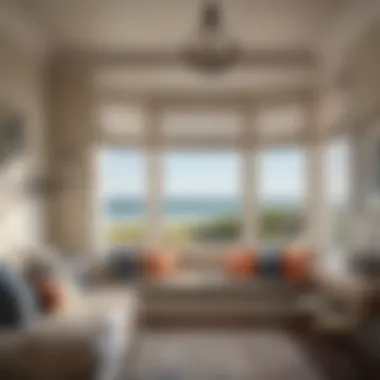

The final aspect of creating a coastal atmosphere involves scent and ambiance. Engaging the olfactory senses can evoke memories of seaside experiences and promote relaxation. A few ways to achieve this include:
- Natural Candles: Choose scents like ocean breeze or coconut to evoke beach memories.
- Essential Oils: Diffuse oils like lavender or eucalyptus, which can inspire calmness and tranquility.
- Air Purifiers: Consider devices that release fresh, clean air while providing a subtle scent reminiscent of the sea.
Combining these elements creates a holistic coastal environment, engaging more than just visual appeal but also sight and scent, resulting in a truly immersive experience.
Sustainable Coastal Design Practices
Sustainable coastal design practices are becoming increasingly necessary in today's world. The principles of sustainability not only protect our environment but also enhance the coastal design aesthetic. By incorporating eco-friendly materials and reducing environmental impact, homeowners can create a master bedroom that reflects both beauty and responsibility.
Sourcing Eco-Friendly Materials
Choosing sustainable materials is one of the key components of a coastal design that minimizes ecological damage. Materials like bamboo, reclaimed wood, and organic cotton contribute to an environmentally friendly space. These options often have a lower carbon footprint compared to traditional materials.
Bamboo is a highly sustainable choice as it grows rapidly and can be harvested without harming the surrounding ecosystem. Reclaimed wood adds character and history while decreasing the demand for new lumber. Opting for organic cotton for bedding ensures the absence of harmful chemicals used in conventional cotton production.
When considering eco-friendly materials, look for certifications like Global Organic Textile Standard (GOTS) or Forest Stewardship Council (FSC). These labels assure consumers that they are choosing products that are both safe and sustainable.
Minimizing Environmental Impact
Minimizing environmental impact involves more than just sourcing materials. It extends to the manufacturing process, transportation, and end-of-life considerations for all products in your design scheme. Selecting locally sourced products reduces transportation emissions. This practice supports local economies and encourages responsible consumption.
Energy-efficient lighting is another avenue for minimizing environmental impact. LED lights use significantly less energy and have a longer lifespan than traditional incandescent bulbs. This simple switch can result in lower energy bills and less frequent replacements, contributing to a more sustainable lifestyle.
Additionally, consider the use of low-VOC paints and finishes. These options reduce harmful chemical emissions in your home, contributing to healthier indoor air quality. Making conscious choices not only preserves the aesthetic but also aligns with a philosophy of care for the environment.
"Sustainable coastal design practices create a space that reflects personal values while embracing the beauty of the coast."
In summary, it is crucial to incorporate sustainable practices in the design of your coastal bedroom. Sourcing eco-friendly materials and minimizing environmental impact offer a dual benefit—creating a stunning space while protecting our precious planet. Homeowners have the opportunity to contribute to a larger movement towards sustainability while enjoying the tranquillity that coastal design brings.
Integrating Technology in Coastal Bedrooms
In today's fast-paced world, technology plays a significant role in enhancing the comfort and functionality of our living spaces. For those looking to create a master bedroom that embodies the coastal lifestyle, integrating technological solutions is essential. This section explores how smart technologies can complement coastal design, contribute to energy efficiency, and enhance the overall living experience.
Smart Lighting Solutions
Lighting is a crucial element in any bedroom, particularly in coastal designs, where natural light is sought to create a serene atmosphere. Smart lighting solutions offer numerous benefits, including customization and energy efficiency. Homeowners can adjust light settings to match different times of the day or activities. For example, dimmable fixtures can help recreate the warm glow of sunset or provide bright illumination for reading.
Some options include:
- Smart bulbs: These can change color and brightness through an app, enabling users to set the perfect ambiance.
- Motion sensors: They turn lights on and off automatically, providing convenience and saving energy.
- Timers: These can help automate lighting according to daily routines or times when one wants the room to appear occupied.
Integrating smart lighting not only enhances aesthetic appeal but also aligns with eco-friendly practices, reducing overall electricity consumption.
Climate Control Technology
Climate control is another critical aspect of a bedroom, especially in coastal areas where humidity can be high. Effective climate control ensures comfort, improves air quality, and promotes relaxation. This can be achieved through smart thermostats and advanced air conditioning systems.
Features to consider include:
- Smart thermostats: These learn your heating and cooling preferences, optimizing energy use.
- Humidity sensors: They can adjust climate settings based on real-time data to maintain ideal moisture levels.
- Smart fans: Ceiling or standing fans can be programmed to circulate air efficiently during warmer months.
"Smart technologies in the bedroom not only create a comfortable environment but also reduce energy costs."
By incorporating these technologies, homeowners can maintain a pleasant climate while emphasizing sustainability, an important component of modern coastal design.
Final Considerations
As we conclude our exploration of coastal design principles for master bedrooms, it is essential to reflect on the Final Considerations. These considerations encapsulate the thought process and decision-making that leads to a harmonious coastal aesthetic. Balancing aesthetics with functionality is crucial. It ensures that your space not only looks serene and inviting but also meets your everyday living needs.
Personalizing Your Space
Personalizing your space is an integral part of mastering coastal design. This process starts with understanding your style and needs. Each individual has unique preferences that can influence design elements. Here are some ways to infuse your personality into your coastal master bedroom:
- Incorporate Personal Artwork: Displaying art that resonates with your experiences or emotions adds a personal touch while maintaining a coastal vibe.
- Use Family Heirlooms: Integrating items passed down from family can echo nostalgia and warmth.
- Pick Meaningful Colors: Consider colors that speak to you, even if they slightly deviate from the typical coastal palette.
A carefully personalized space not only reflects your personality but also becomes a sanctuary, promoting relaxation and peace.
Maintaining Coastal Design Elements
Maintaining the coastal design elements involves ongoing attention. These elements require consideration beyond initial setup. Here are some approaches to ensure longevity and relevance of your design:
- Seasonal Updates: Change out decor elements as seasons change. This can include swapping pillow covers or light fixtures to reflect the current mood.
- Regular Cleaning: Keeping materials like natural fiber textiles and reclaimed wood furniture clean is essential to retain their character. Dust and salt from coastal environments can accumulate quickly, requiring regular maintenance.
- Evaluate Trends: While coastal design has timeless qualities, trends evolve. It's wise to periodically assess whether any updates align with your aesthetic and functionality needs.
To keep a coherent design, always revisit your space. Ensuring it aligns with evolving tastes can breathe new life into your retreat.
Remember, designing is a journey. Each decision creates a unique reflection of you within your home.



